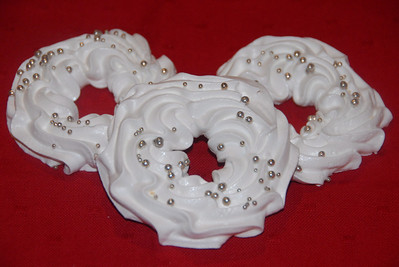
After a long season of munching on buttery cakes, iced cookies, and gooey candy the last thing that I want to bake, or eat, is dessert. I do, however, make an exception for meringues. Take one bite of an ethereally light meringue and you’ll understand why this confection was originally dubbed “sugar puff.” Crafted from egg whites and granulated sugar, this is one of the daintiest and simplest sweets that you’ll ever taste.
As a child, I associated meringue with the browned peaks capping off my mom’s coconut cream and lemon meringue pies. Yet, as I later learned, it is so much more than a topping for creamy treats. Where would ile flottante be without its white, fluffy islands or baked Alaska without its elegant, insulating alps? Minus meringue both become pools of cream sloshing about on our plates. Without question meringue remains the backbone of these and many other desserts.
Debate over the origins of this airy treat has raged on for decades. Some culinary historians credit the Swiss pastry chef Galasparini in the German town of Meiringen with meringues. Yet others point to a cook in the 18th century Duke of Lorraine’s kitchen as the creator of the first egg white delight.
Whoever did whisk together the first meringue unwittingly invented a longstanding, global hit. Eighteenth century French Queen Marie Antoinette reputedly loved meringues so much that she whipped up her own in the palace kitchen. Two centuries later Australian fans awarded the meringue-based pavlova the title of Australia’s national dessert.
Created in honor of the Russian ballerina Anna Pavlova, the pavlova consists of a meringue shaped in the form of a round basket or cake. Covered with whipped cream and then layered with strawberries, kiwi, bananas, peaches, raspberries or a combination thereof, the “pav” wows with its beautiful presentation and ease of preparation.
To make a meringue, I use an electric mixer to whip egg whites into a foam. Foam formed, I slowly add a little granulated sugar and continue beating. After the egg whites have doubled in size and soft peaks appear, I gradually pour in the rest of the sugar and continue to beat the mixture. When glossy, stiff peaks pop up, I am ready to slather the meringue over a pie or pipe it through a pastry bag or spoon it onto parchment paper and bake it.
If I am baking the meringue sans pie, I slip the parchment paper into an oven preheated to 275 degrees. After an hour has passed, I turn off the oven and allow the meringue to cook inside for another 3 hours or so. Due to the lengthy baking time I often start my meringue before going to bed and allow it to bake overnight.
When craving a crisp exterior but chewy interior — the consistency of pavlovas — I include either cornstarch or a tablespoon of vinegar in my ingredients list. After I have beaten my egg whites and sugar into stiff peaks, I fold the cornstarch or vinegar into the meringue. If I want to flavor my meringue with chocolate or ground nuts, I also add these at this time.
Easy to make. Light and delicious to eat. It’s no wonder that meringues remain my favorite “I’m-so-tired-of-sweets” sweet.
CHOCOLATE RASPBERRY PAVLOVA
Adapted from Nigella Lawson’s “Forever Summer” (Hyperion, 2003)
Serves 8 to 10
6 egg whites
1 cup granulated sugar
3 tablespoons unsweetened cocoa powder, sifted
1 teaspoon balsamic vinegar
2 ounces bittersweet chocolate, finely chopped
container of store-bought whipped cream
1 pint raspberries, washed and dried
2-3 tablespoons grated semi-sweet chocolate
Preheat the oven to 350 degrees Fahrenheit. Line a baking sheet with parchment paper.
Beat the egg whites until satiny peaks form and then beat in the sugar a spoonful at a time until the meringue is stiff and shiny.
Sprinkle in the cocoa, vinegar and chopped chocolate then gently fold until everything is mixed. Mound the meringue onto a baking sheet in a fat circle roughly 9 inches in diameter.
Place the baking sheet in the oven then immediately turn the temperature down to 300 degrees Fahrenheit. Cook for 1 to 1¼ hours until its crisp around the edges and sides and dry on top. There should still be some give to the center of the meringue. Turn off the oven and, leaving the meringue inside, allow it to cool completely.
When ready to serve, cover the top with whipped cream, followed by the berries and shavings of chocolate.
LIZ THEISEN’S STRAWBERRIES ROMANOFF IN MERINGUES
Makes 10 to 12
2 quarts ripe strawberries, washed
1 (6-ounce) can frozen orange juice concentrate, defrosted
1 cup port wine
Sugar
3 tablespoons Mandarine liqueur
2 cups heavy whipping cream
Forgotten Meringues (recipe follows)
Flowers or flower petals or shelled pistachios
Hull strawberries and place in a large bowl. Add orange juice concentrate and port and season to taste with a little sugar, if desired. Gently stir and allow berries to mellow in this mixture for 2 hours. Add Mandarine liqueur, taste and add more sugar, if desired. Whip cream with or without sugar to taste. Fill meringue shells with berries, garnish with flowers or pistachios and serve with whipped cream on the side.
Forgotten Meringues:
6 egg whites
1-1/2 teaspoons lemon juice or 1/2 teaspoon cream of tartar
2 cups sugar
Beat egg whites with lemon juice or cream of tartar until frothy. Gradually add sugar and beat until stiff and glossy. Pipe into 12 nest shapes or drop by small spoonfuls in circles on brown paper on a baking sheet. Place tray in preheated 400-degree oven, close door and turn off the heat. (Don’t peak!) Let stand overnight in the oven. Meringues will be baked by morning.